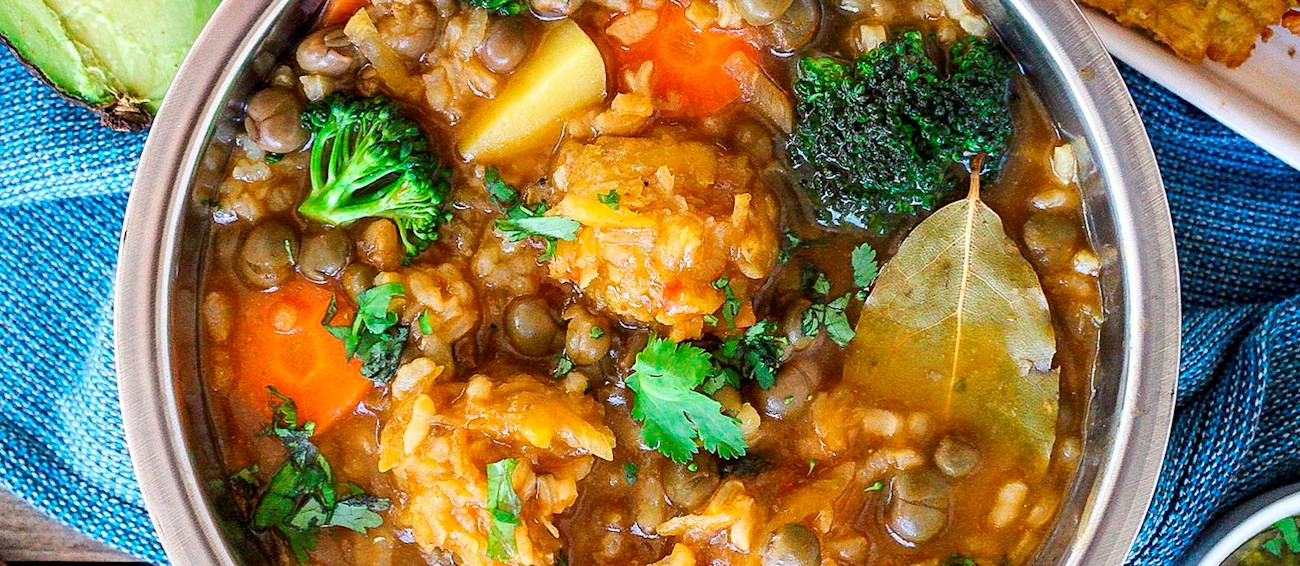Oil down is the national dish of Grenada, a humble dish from a humble country and a flavorful one-pot meal consisting of local vegetables, starchy tubers, green bananas, salty meat, and a blend of various seasonings. The ingredients are all combined in a big pot and cooked in coconut milk, giving the dish its name, referring to the coconut milk as it simmers and gets absorbed by all the other ingredients until only the coconut oil remains on the bottom of the pot.
The preparation of this dish is important as the dish itself, because it is traditionally cooked over an open fire on the beaches where families spend their whole days and everybody pitches in to help so that a true communal feeling emerges while the dish cooks for a few hours.
MAIN INGREDIENTS
Asopao de gandules is a variety of Puerto Rican asopao, made with pigeon peas as the key ingredient. They are typically combined with onions, ham, sofrito, chicken stock, rice, tomato sauce, and olive oil. The result is a hearty stew that is often enriched with plantain dumplings, when the dish is known as asopao de gandules con bolitas de platano.
Chock-full of Hispanic ingredients, the stew is ready for consumption when thickened, and the rice is fully cooked. It is recommended to serve it warm, but it can also be reheated and enjoyed the next day.
MAIN INGREDIENTS
Asopao is a Puerto Rican dish that is best described as a cross between a soup and a stew. It always contains rice, and can be made with beef, pork, seafood, pigeon peas, or chicken – which is also the most popular and traditional version of asopao, called asopao de pollo, where the chicken is typically flavored with various spices and cooked with ham, peppers, onions, tomatoes, olives, and sausages.
Due to the fact that asopao is usually very filling and flavorful, it can be found in numerous local restaurants and most households.
VARIATIONS OF Asopao
Karni stoba is a traditional Caribbean stew originating from Curaçao. In order to prepare it, chunks of beef are marinated with pepper and garlic, seared, then combined with bell peppers, onions, tomatoes, chili peppers, soy sauce, stock, cumin, and nutmeg.
The dish is cooked slowly until the meat becomes tender and the stew develops a thick consistency. This fragrant stew is often garnished with cilantro, and it is recommended to serve it with steamed white rice.
MAIN INGREDIENTS
Carne guisada is a simple, traditional beef stew flavored with cumin, jalapeños, and chili powder. It is popular throughout Latin America, especially in Mexico, Puerto Rico and the Dominican Republic. The dish is usually simmered over low heat for about two hours until the meat becomes tender.
It is recommended to serve it on flour tortillas, although it can also be paired with rice or potatoes.
Chivo guisado is a Dominican goat stew. It is usually prepared with pieces of goat meat, onions, bitter oranges, garlic, and tomatoes, while the secrets to this delicacy are wild oregano and Scotch bonnet peppers. Local goats feed on wild oregano, which is the reason for great flavors of chivo guisado.
It is recommended to serve this tender and flavorful stew with chenchén (cracked corn pilaf), which is another delicacy from this country.
Brown stew fish is a Jamaican delicacy made by combining marinated and fried fish fillets with a brown sauce consisting of onions, garlic, ginger, tomatoes, butter, and water. The stew is often additionally seasoned with thyme and various types of hot peppers.
It is traditionally served with rice and peas or yams and bananas on the side.
Run down is a flavorful Jamaican fish stew that is traditionally cooked in a mix of coconut milk, onions, garlic, and tomatoes until it develops a thick consistency. The fish used in run down is usually cod or mackerel, cut into larger pieces. It is recommended to serve the stew with dumplings, rice, or boiled plantains on the side.
This dish is also popular in Nicaragua and Trinidad.
TasteAtlas food rankings are based on the ratings of the TasteAtlas audience, with a series of mechanisms that recognize real users and that ignore bot, nationalist or local patriotic ratings, and give additional value to the ratings of users that the system recognizes as knowledgeable. TasteAtlas Rankings should not be seen as the final global conclusion about food. Their purpose is to promote excellent local foods, instill pride in traditional dishes, and arouse curiosity about dishes you haven’t tried.












